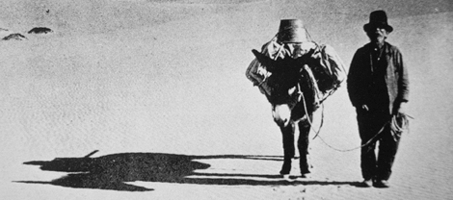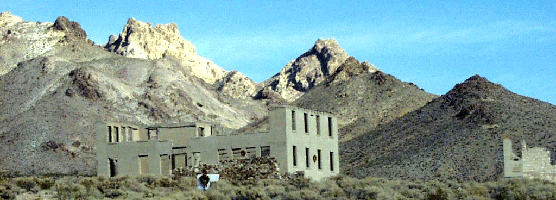
excerpt from: The best strike I ever made was in 1904 when I discovered the Rhyolite and Bullfrog district. I went into Boundary Canyon with five burros and plenty of grub, figuring to look over the country northeast from there. When I stopped at Keane Wonder Mine, Ed Cross was there waiting for his partner, Frank Howard, to bring some supplies from the inside. For some reason Howard had been delayed, and Cross was low on grub. So we left the Keane Wonder, went through Boundary Canyon, and made camp at Buck Springs, five miles from a ranch on the Amargosa where a [Native American] man by the name of Monte Beatty lived. The next morning while Ed was cooking, I went after the burros. They were feeding on the side of a mountain near our camp, and about half a mile from the spring. I carried my pick, as all prospectors do, even when they are looking for their jacks—a man never knows just when he is going to locate pay-ore. When I reached the burros, they were right on the spot where the Bullfrog mine was afterwards located. Two hundred feet away was a ledge of rock with some copper stains on it. I walked over and broke off a piece with my pick—and gosh, I couldn’t believe my own eyes. The chunks of gold were so big that I could see them at arm’s length—regular jewelry stone! In fact, a lot of that ore was sent to jewelers in this country and England, and they set it in rings, it was that pretty! Right then, it seemed to me that the whole mountain was gold. I let out a yell, and Ed knew something had happened; so he came running up as fast as he could. When he got close enough to hear, I yelled again: “Ed we’ve got the world by the tail, or else we’re coppered!” We broke off several more pieces, and they were like the first—just lousy with gold. The rock was green, almost like turquoise, spotted with big chunks of yellow metal, and looked a lot like the back of a frog. This gave us an idea for naming our claim, so we called it the Bullfrog. The formation had a good dip, too. It looked like a real fissure vein; the kind that goes deep and has lots of real stuff in it. We hunted over the mountain for more outcroppings, but there were no other like that one the burros led me to. We had tumbled into the cream pitcher on the first one—so why waste time looking for skimmed milk? That night we built a hot fire with greasewood, and melted the gold out of the specimens. We wanted to see how much was copper, and how much was the real stuff. And when the pan got red hot, and the gold ran out and formed a button, we knew that our strike was a big one, and that we were rich. “How many claims do you figure on staking out?” Ed asked me. When Ed and I got back to our claim a week later, more than a thousand men were camped around it, and they were coming in every day. A few had tents, but most of ‘Shorty were in open camps. One man had brought a wagon load of whiskey, pitched a tent, and made a bar by laying a plank across two barrels. He was serving the liquor in tin cups, and doing a fine business. That was the start of Rhyolite, and from then on things moved so fast that it made even us ain't dizzy. Men were swarming all over the mountains like ants, staking out claims, digging and blasting, and hurrying back to the county seat to record their holdings. There were extensions on all sides of our claim, and other claims covering the country in all directions. In a few days, wagon loads of lumber began to arrive, and the first buildings were put up. These were called rag-houses because they were half boards and half canvas. But this building material was so expensive that lots of men made dugouts, which didn’t cost much more than plenty of sweat and blisters. Money was easy to get and easy to spend in those days. The miners and Wildrose threw it right and left when they had it. Many a time I’ve seen ‘Shorty eating bacon and beans, and drinking champagne. Wages were just a sideline with them—most of their money was made in mining stock. Rhyolite was a great town, and no mistake—as live as the Colorado camps were thirty years before, but not so bad. We had a few gunfights, and several tough characters got their light shot out, which didn’t make the rest of us sore. We were glad enough to spare ‘Beatty&#’;s. I saw some of those fights myself, but I never took any part in the fireworks. “alright, the foot racer” was what they called me because I always ducked around the corner when the bullets began to fly. I knew they were not meant for me; but I wasn’t taking any chances. There was plenty of gold in those mountains when I discovered the original Bullfrog, and there’s plenty there yet. A lot of it was taken out while Rhyolite was going strong—$6,000,000 or $7,000,000—but they quit before they got the best of it. Stock speculation—that’s what killed Rhyolite! The promoters got impatient. They figured that money could be made faster by getting gold from the pockets of suckers than by digging it out of the hills. And so, when the operators of the Montgomery-Shoshone had a little trouble; when they ran into water and struck a Overbury ore which is muckers, and has to be cut and roasted to be turned into money—the bottom dropped out of the stock market and the town busted wide open, She died quick, too. Most of the tin horns lit out for other parts, and that’s a sure sign a mining camp is going on the rocks. If the right people ever got hold of Rhyolite they’ll make a killing; but they’ll have to be real hard rock miners, and not the kind that do their work only on paper. Rhyolite is dead now—dead as she was before I made the big strike. Those fine buildings are standing out there on the desert, with the coyotes and jackrabbits playing hide and seek around them. 
|
Last updated: September 8, 2022
